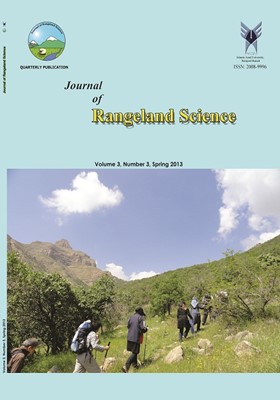Effects of Salinity on Seedling Growth and Physiological Traits of Vetiver Grass (Vetiveria zizanioides Stapf)
محورهای موضوعی : Relationship between Animal and RangelandDavoud Akhzari, 1 , Alireza Ildoromi 2 , Maryam Dashti Marvili 3
1 - Assistant Professor, Department of Watershed and Rangeland Management, Malayer University, Iran
2 - Assistant Professor, Department of Watershed and Rangeland Management, Malayer University
3 - Post Graduate Student of Watershed Management.
کلید واژه: Halophytes, Rangelands, Saline, salinity stress,
چکیده مقاله :
Vetiver grass (Vetiveria zizanioides) is known to be survived under the diversesoil and water conditions. In order to study the effects of salinity stress on the seedlinggrowth of the desired species, a completely randomized design was conducted with 3replications. Seeds were sown in the salty-soil plots in the greenhouse. Salinity levels werespecified as 4 control ones including 20, 30 and 40 dS/m. Results showed that the seedlinggrowth and yield were progressively declined by the increase of NaCl concentration levels.The concentrations of both chlorophylls a and b were dramatically increased by increasingNaCl and the highest and lowest values have been obtained for the levels of 40 and 4 dS/m,respectively. There were no significant differences for the leaf area and water content withthe salinity of 20 dS/m as compared to the control treatment. The concentrations ofchlorophylls a and b were 0.73 and 0.41(mg/g FW) and 0.35 and 0.11 (mg/g FW) in the 40and 4 dS/m salinity treatments, respectively. Leaf water content for 4 and 20 dS/m salinitylevels has been calculated as 11.3 and 9.8 percent. But there was a significant reduction inthe leaf water content with 30 and 40 dS/m salinity levels. Leaf water content with 30 and40 dS/m salinity level was 6.3 and 5.2 %. Leaf area in 4, 20, 30 and 40 dS/m salinity levelshas been computed as 172, 168.7, 81.7 and 65.2 cm2, respectively. Compared to the controltreatments, there was a significant reduction in leaf area with 30 and 40 dS/m salinitylevels. Our results suggest that in an EC between 4 to 20 dS/m, Vetiveria zizanioides couldgrow.


